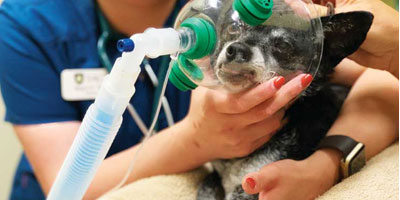
Increasing depth of anesthesia with Isoflurane isoflurane USP may increase hypotension and respiratory depression. In this way the cat or dog stops feeling pain.

I had her annual dental cleaning done a few days ago and her whining and anxiousness has gotten worse.
Side effects for anesthsia for dog gas. Sucking vomit into their lungs can trigger an episode of aspiration pneumonia which can be life-threatening. More rare reactions to dog anesthesia are side effects like seizures visual impairments clotting disorders like von Willebrands disease in dogs and system organ failures of the liver kidney or heart. Since gas anesthesia cannot anesthetize the animal but only provides quality sleep the pet is injected with anesthetics or an epidural anesthesia for example for spaying blocking the nerve endings.
In this way the cat or dog stops feeling pain. Large doses of intravenous anesthetic agents or sedative gases may damage the reticular activating system in the brain that controls the awareness. This is a rare side effect of general anesthesia in dogs.
But it happens because of extra-high doses of anesthetic agents drugs. General anesthesia makes your dog unconscious so he wont move or feel pain. While under anesthesia your pet will receive monitoring and.
Dexdomitor and other alpha-2 agonists may also be used for premedication. These drugs are effective sedatives but common side effects include bradycardia decreased cardiac output vasoconstriction and increased systemic vascular resistance. Prior to anesthesia induction an IV catheter should be placed.
My Basset Hound 12 is in the early stages of Canine Cognitive Dysfunction doggy dementia. I had her annual dental cleaning done a few days ago and her whining and anxiousness has gotten worse. After doing some more research several people have found that the gas anesthesia is not recommended for dogs with this condition.
Animal experiments provide no clear conclusion concerning a possible carcinogenic risk from inhaled anesthetics. Acute and chronic toxicity in humans Occupational exposures to anesthetic gases involve concentrations much smaller than those administered to patients in surgery. However the side effects of anesthetic gases on patients are of.
The second gas effect is a phenomenon by which the rapid uptake by blood of large volumes of a gas from the alveoli acts to enhance the uptake of the remaining alveolar gases. This effect is most pronounced in the early stages of induction and has been used to speed anesthetic induction. The effect is usually seen clinically with concurrent.
Studies have shown that some dogs can experience adverse drug reactions as a result of anesthesia. Important factors to consider are. Age of the Dog.
Dogs that belong to the Brachys Breed react to anesthesia by constricting the airway which might cause breathing difficulties. If you are the owner of a dog belonging to the Sighthounds Breed. Your dog needs to fast before being put under anesthesia and if you dont adhere to that policy your dog could vomit during the procedure and choke or.
My dog is nauseous. Nausea is a common side effect of the sedation and anesthetic drugs and should pass within 12-24 hours of the surgery. The poor pup may even vomit a little.
You can try feeding your dog a small soft very bland meal as long as the vet has said its okay to do so. Other rare complications of anesthesia include organ system failure such as kidney liver or heart failure visual impairment clotting disorders and seizures. Your veterinarian will take every precaution to minimize these risks during your dogs anesthesia.
Only when the benefits outweigh the risks will they perform anesthesia on your dog. Generally any effects of anesthesia will pass within 48 hours of surgery. Digestive dog sedation side effects include diarrhea and vomiting.
What are the other side effects of anesthesia. Besides shaking or shivering dogs may experience a few other side effects especially within the first couple of days post-surgery. This includes behavioral changes and affected ability to control body temperature.
The sedative has an additional use of counteracting undesired opioid side effects in particular excitement reactions and opioid-induced vomiting. There is nothing new about the use of such combinations veterinarians having used them for many. You may also feel any of these common side effects.
Nausea and vomiting. This common side effect usually occurs immediately after the procedure but some people may continue to feel sick for a. A mixture of gas and oxygen will be administered through a tube in the windpipe to maintain anesthesia during surgery.
A local anesthetic procedure would likely just include a single injection. Concerned owners should discuss what types of drugs will be used on their dog with the veterinarian especially if the dog has previously had a. Common anesthesia side effects.
Some of the most common anesthesia side effects in cats include allergic reactions which can be localized or system-wide. These reactions can result in swelling in your cats body which could affect his ability to breathe. Isoflurane isoflurane USP is contraindicated in horses and dogs with known sensitivity to isoflurane or to other halogenated agents.
Increasing depth of anesthesia with Isoflurane isoflurane USP may increase hypotension and respiratory depression. Be sure you understand and follow the discharge instructions. Most pets that have surgery go home on pain medications so make sure youre aware of possible side effects.
Give your pet a couple of days to fully recover. Usually pets are pretty drowsy the first night after anesthesia and many have no interest in food.